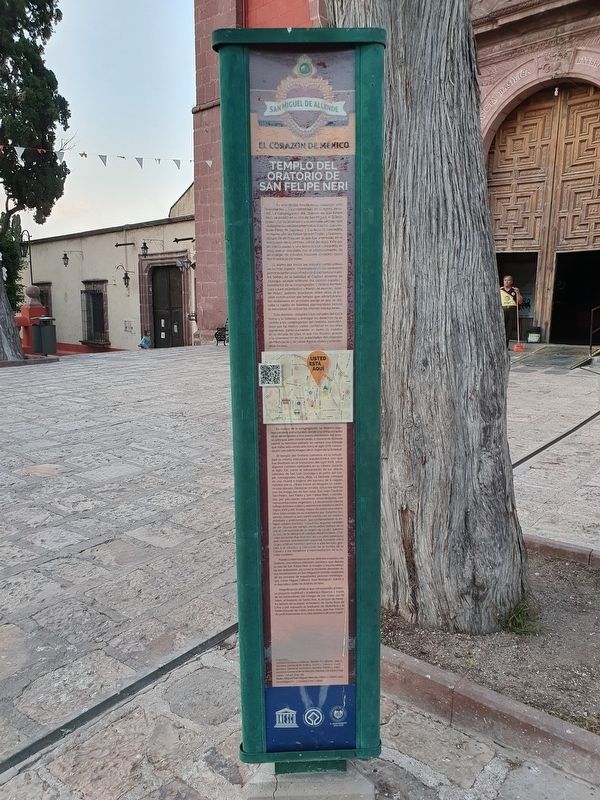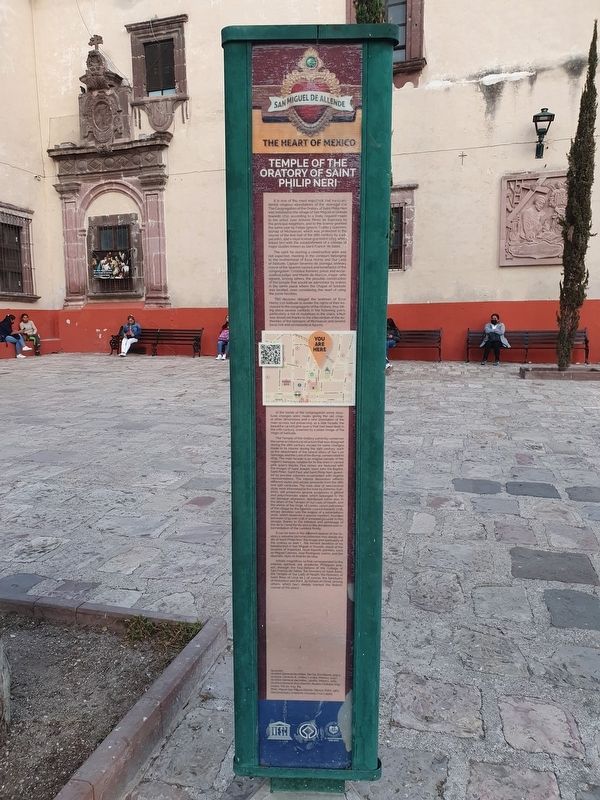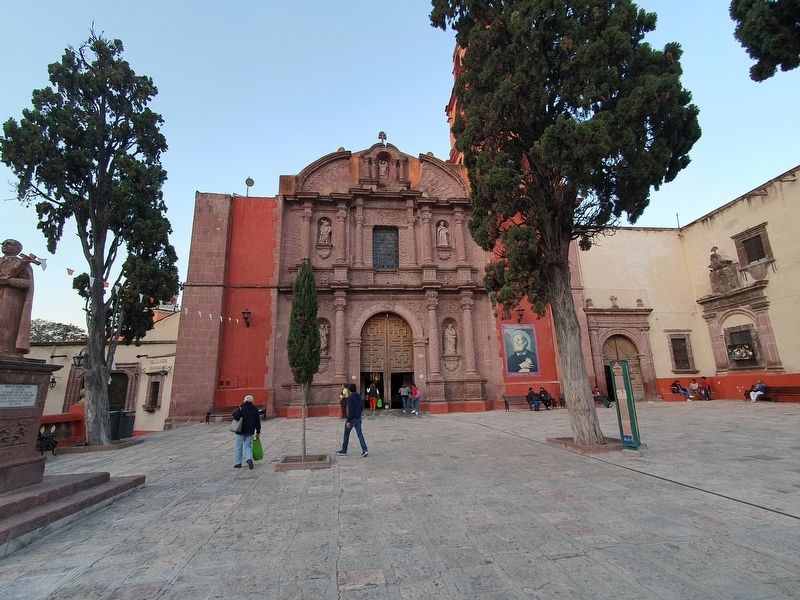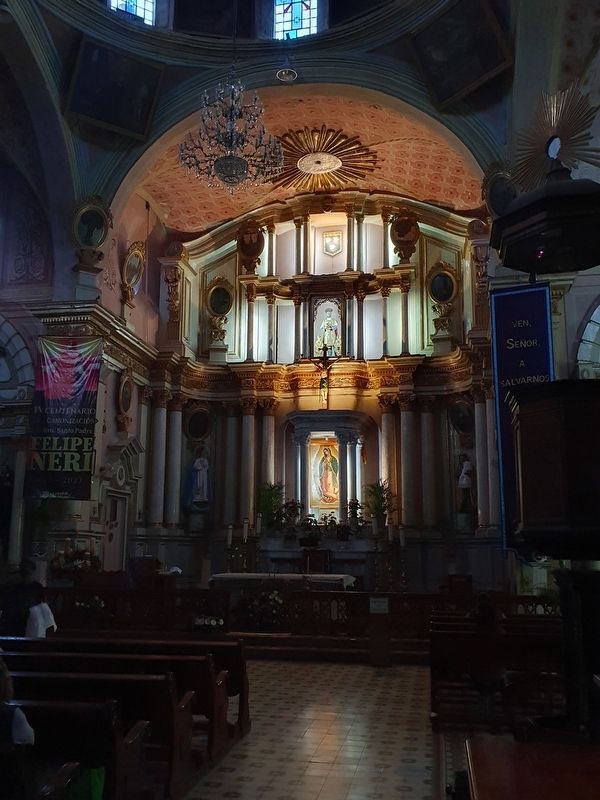Zona Centro in San Miguel de Allende, Guanajuato, Mexico — The Central Highlands (North America)
Temple of the Oratory of Saint Philip Neri
San Miguel de Allende
— El Corazón de México - The Heart of Mexico —
Inscription.
Es una de las formaciones religiosas importantes y trascendentales de la epoca virreal. La Congregacíon del Oratorio de San Felipe Neri se instaló en la villa de San Miguel el Grande hacia 1712 de acuerdo a la animada petición que realizaron los vecinos principales al padre Juan Antonio Pérez de Espinoso, y a la licencia ya concedida el mismo año por Felipe Ignacio Trujillo y Guerrero, obispo de Michoacán, la que fue amparada en el transcurso de la primera mitad del siglo XVIII por un edicto papal y una licencia real concedida en 1753, que le vinculaba con el establecimiento de un colegio de estudios mayores conocido como San Francisco de Sales.
El ánimo por iniciar los trabajos constructivos no se hizo esperar, reuniédose en los contornos pertenecientes a la cofradia de Ecce Homo y Nuestra Señora de la Soledad, el Capitán Severino de Jauregui, alcalde ordinario del cabildo español y benefactor de la congregación, Cristóbal Ramirez cura y juez eclesiástico y Martin de Alarcon alcalde mayor, quienes acordaron, entre otros, la posible construcción del templo que administrarian los oratorianos en el mismo paraje en que se ubcaba la capilla de Soledad, planteándose incluso la necesidad de utilizar las mismas instalaciones.
Esta decisión, obligaba a los cofrades del Ecce Homo y la Soledad a entregar los derechos de su recinto a los congregantes del Oratorio, sucediéndose por tal motivo varios confictos en los años siguientes, particularmente u motin de mulatos en la década de 1740, el que fue disuelto gracias a la intervención de las autoridades del obispado de Michoacán y de varias figuras civiles y eclesiásticas locales.
En manos de la congregación, se hicieron algunos cambios estructurales, dando a la antigua capilla otras dimensiones y una nueva orientación del acceso principal, pero conservando, a manera de fachada lateral, la hermosa portada en cantera rosa labrada que habia sido construida hacia el siglo XVII, coronada por una sobria imagen de la virgen de la Soledad.
El templo del Oratorio conserva en la actualidad la misma estructura arquitectónica con que fue diseñado en el transcurso del siglo XVIII, salvo algunos cambios realizados en su interior durante el siglo XIX, como el adosamiento de los altares laterales de San Luis Gonzaga y el señor del Golpe, consagrados hacia 1835. La fachada principal es una muestra original del barroco de la región, notable por sus finos trazos en bloques de cantera rosa labrada. Destacan
en ella, cinco hornacinas con las imágenes de San José, San Juan Bautista.
San Pedro, San Pablo y San Felipe Neri, custodiadas por peculiares columnas ornamentadas con representaciones vegetales. La decoración interior
refleja distintos estilos y elementos artisticos de los
siglos XVIII y XIX. El altar mayor de estilo neoclásico, obra intervenida en su momento por Zeferino Gutiérrez, conserva aún varias esculturas en madera estofada y policromada, que pertenecieron al antiguo retablo barroco, repartidas algunas también en los altares del templo da Nuestra Señora de la Salud y el camarín de la virgen de Loreto, patrona Jurada de la villa por el cabildo español hacia 1730, cuya devoción fue el motor de una obra ostentosa
que merece una mención especial, fundada entre 1734 y 1736 en terrenos anexos a este templo, gracias a la iniciativa y patrocinio de la familia de la Canal y a los donativos e intermediación de la familia Landeta.
Puede contemplarse en los distintos espacios del Oratorio, una valiosa colección pictórica, que detalla la vida de San Felipe Neri, la imagen y espiritualidad de los oratorianos asi como la ferviente devoción de sus benefactores en San Miguel el Grande, resultado de los pinceles de importantes pintores novohispanos como Miguel Cabrera, José Rodriguez Juárez y el dramático estilo de Andrés de Islas.
Magnificencia artística que correspondía
al intenso proyecto espiritual y académico filipense, a través de las fundaciones del Colegio de San Francico de
Sales, el beaterio de Santa Ana, el templo de Nuestra Señora de la Salud, el beaterio de Santa Rosa de Lima y por supuesto el Santuario de Atotonilco y la Santa Escuela de Cristo, entre otras, que han marcado profundamente el rumbo histórico de este lugar.
Fuentes
Archivo General de Indias, Sevilla, Escribanía, 209 A
Archivo General de Indias, Sevilla, Mexico, 1047
Archivo General de Indias, Sevilla, México, 1061
Archivo General de la Nación, Reales Cédulas Originales, Vol. 40. Exp. 89
Malo, Miguel, San Miguel Allende, México. INAH, 1953
Investigación Graciela Cruz López
Temple of the Oratory of Saint Philip Neri
It is one of the most important and transcendental religious foundations of the viceregal era. The Congregation of the Oratory of Saint Philip Neri was installed in the village of San Miguel el Grande towards 1712, according to a lively request made to the priest Juan Antonio Pérez de Espinosa by the principal neighbors, and to the license granted the same year by Felipe Ignacio Trujillo y Guerrero, bishop of Michoacán, which was protected in the course of the first half of the 18th century by a papal edict, and a royal license granted in 1753, which linked him with
the establishment of a college of
major studies known as Saint Francis de Sales.
The spirit for starting a constructive work was not expected, meeting in the contours belonging to the brotherhood of Ecce Homo and Our Lady of Solitude, Captain Severino de Jauregui, ordinary mayor of the Spanish council and benefactor of the congregation, Cristóbal Ramirez, priest and ecclesiastical judge, and Martin de Alarcón, mayor who agreed, among others, the possible construction of the temple that would be administer by orators in the same place where the Chapel of Solitude was located, even considering the need of using the same facilities.
This decision obliged the brethren of Ecco Homo and Solitude to render the rights of their enclosure to the congregants of the Oratory, thus taking place several conflicts in the following years, particularly a riot of mulattoes in the 1740s, which was dissolved thanks to the intervention of the authorities of the bishopric of Michoacán and several local civil and ecclesiastical figures.
In the hands of the congregation some structural changes were made, giving the old chapel other dimensions and a new orientation of the main access, but preserving, as a side facade, the beautiful carved pink quarry that had been built in the 17th century, crowned by a sober image of the Virgin of Solitude.
The Temple of the Oratory currently conserves the same architectural structure that was designed during the 18th century, except for some changes made in its interior during the 19th century, such as the attachment of the lateral altars of San Luis Gonzaga, and the Lord of the Bump, consecrated to 1835. The main facade is an original sample of the region's baroque, notable for its fine lines in carved pink quarry blocks. Five niches are featured with the images of Saint Joseph, Saint John the Baptist. Saint Peter, Saint Paul and Saint Philip Neri, guarded by peculiar columns ornamented with vegetal representations. The interior decoration reflects different styles and artistic elements from the 18th and 19th centuries. The main altar of neoclassical style, work intervened at the time by Zeferino Gutiérrez, still preserves several sculptures in gilded and polychromatic wood, which belonged to the old baroque altarpiece, distributed some also in the altars of the Temple of Our Lady of Health, and the shrine of the Virgin of Loreto, sworn patroness of the village by the Spanish council towards 1736, whose devotion was the engine of a ostentatious work, which deserves a special mention, founded between 1734 and 1736 in annexed grounds to this temple, thanks to the initiative and patronage of the de la Canal family and to the donations and intermediation of the Landeta family.
It can be seen in the different spaces of the Oratory a valuable pictorial collection that details the life of Saint Philip Neri, the image and spirituality of the orators, as well the fervent devotion of his benefactors in San Miguel el Grande, result of the brushes of important novohispanic painters, such as Miguel Cabrera, José Rodriguez Juárez, and the dramatic style of Andrés de Islas.
Artistic magnificence that corresponded to the intense, spiritual, and academic Philippian project, through the foundations of the College of San Francis de Sales, the Nunnery of Saint Anne the Temple of Our Lady of Health, the Nunnery of Saint Rose of Lima ant of course, the Sanctuary of Atotonilco and the Holy School of Christ, among others, which have deeply marked the historic course of this place.
Sources
Archivo General de Indias, Sevilla, Escribanía, 209 A
Archivo General de Indias, Sevilla, Mexico, 1047
Archivo General de Indias, Sevilla, México, 1061
Archivo General de la Nación, Reales Cédulas Originales, Vol. 40. Exp. 89
Malo, Miguel, San Miguel Allende, México. INAH, 1953
Documentary research Graciela Cruz López
Topics. This historical marker is listed in these topic lists: Arts, Letters, Music • Charity & Public Work • Churches & Religion • Colonial Era. A significant historical year for this entry is 1712.
Location. 20° 54.972′ N, 100° 44.527′ W. Marker is in San Miguel de Allende, Guanajuato. It is in Zona Centro. Marker is at the intersection of Insurgentes and La Soledad, on the right when traveling north on Insurgentes. Touch for map. Marker is at or near this postal address: Insurgentes 20, San Miguel de Allende GTO 37700, Mexico. Touch for directions.
Other nearby markers. At least 8 other markers are within walking distance of this marker. Doctor Juan Antonio Pérez de Espinosa (a few steps from this marker); Luis Neri de Alfaro y Velázquez (within shouting distance of this marker); Tribute to the Battle of Puebla (within shouting distance of this marker); The First Spanish Prisoners (within shouting distance of this marker); Tellez Delgado Gas Pump (about 90 meters away, measured in a direct line); House of Pedro Vargas (about 120 meters away); The Remains of the Insurgents (about 150 meters away); Saint Francis Religious Ensemble (about 150 meters away). Touch for a list and map of all markers in San Miguel de Allende.
Credits. This page was last revised on March 22, 2023. It was originally submitted on March 22, 2023, by J. Makali Bruton of Accra, Ghana. This page has been viewed 63 times since then and 11 times this year. Photos: 1, 2, 3, 4. submitted on March 22, 2023, by J. Makali Bruton of Accra, Ghana.



